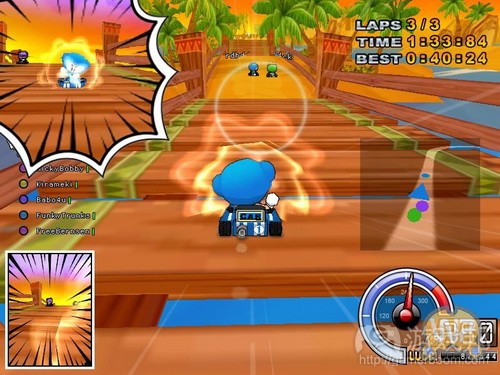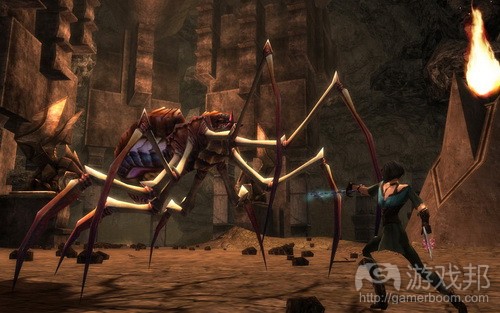阐述免费游戏的10种创收模式
以下10大营收模式令相关游戏或虚拟世界能够以免费模式呈现。排序不分先后。
1. 虚拟道具销售
这是首先出现于韩国的营收模式,现在已成为亚洲主流模式。Nexon(游戏邦注:代表作品有《跑跑卡丁车》、《枫之谷》和《劲舞团》)是此领域公认先驱,其2005年创收2.3亿美元,其中85%的收入来自虚拟道具销售。
在虚拟道具销售模式中,玩家能够购买供玩法内外使用的功能性、装饰性和功能性&装饰性道具。虚拟道具机制通常使用两种货币——符号货币(玩家能够通过游戏活动赚取虚拟货币)和基于金钱的货币(玩家通过实钱购买货币)。通常5-15%的用户会选择后种货币,真实货币是虚拟道具销售模式的收入来源。
虚拟道具销售的魅力在于不受限制的ARPU(每用户平均收入)。据Three Rings CEO Daniel James表示,有些《海盗时代》硬核玩家甚至投入1万多美元购买虚拟道具。而《魔兽世界》每月15美元订阅费模式若要达到这种人均消费水平,至少得让一名用户连续55年玩游戏。
2. 分级订阅模式
《江湖》(Jagex推出的Java MMO游戏)是分级订阅领域的主导作品。在分级订阅模式中,玩家能够免费体验核心游戏,但若想要接触精英武器或其他游戏内容,就需支付少量订阅费用(5美元/月)。在600多万《江湖》玩家中,超过100万用户选择分级订阅模式,每年给Jagex创造6000万美元收益。
《Dungeon Runners》(NCsoft推出的免费MMO游戏)提供类似5美元/月的订阅包,玩家因此能够访问精英道具、银行以及收集魔药。这还能让玩家享有优先权。
3. 广告
前几年涌现许多基于游戏的广告营收模式。Massive、IGA和Double Fusion之类的公司专门帮助EA、动视、THQ和微软等客户执行各种游戏广告项目。游戏广告代理机构通常在适当游戏场景(如体育、比赛或现代射击)中插入静态或动态广告(游戏邦注:前者呈现某种产品,不会发生变化,后者通过网络即时更新)。
据准确行业信息显示,此传统游戏广告市场目前规模达1-2亿美元。但植入动态广告的游戏数量和质量均出现显著提高。Yankee Group因此预测,游戏广告市场2010年的规模将增至7.32亿美元。
但行业还涌现其他新兴游戏广告模式,令玩家能够免费体验内容。例子包括:
* 谷歌广告联盟的PPC广告
* 赞助道具销售(《哈宝旅馆》)
* 游戏视频广告(《Real Networks》)
4. 房产或“土地使用费”
《Second Life》是此模式的主要采用者,游戏向个人租售虚拟土地。月租赁费用从5-195美元不等,由土地规模决定。玩家也可通过一次性支付1675美元及每月的295美元费用购买自己的土地。
约70%的《Second Life》收入来自土地销售和维护费用。当然虚拟土地所有权销售模式也非毫无缺陷,Bragg与Linden诉讼案件就是个很好说明。
《安特罗皮亚世界》以土地拍卖作为营收来源,但之前10万美元土地销售这一现象就受到质疑,因为中标者是游戏开发商MindArk的雇员。
5. 周边商品
菲比玩具已成为普遍现象,网娃毛绒玩具和相关网娃世界已经迅速掳获青少年族群的芳心。玩家可以在零售商店以15美元购买网娃毛绒玩具,然后在网娃世界激活相关虚拟角色。除购买毛绒玩具之外,进入网娃世界无需支付额外费用。
自2005年4月以来,网娃毛绒玩具已售出200万个,其中有超过100万用户在线注册宠物。此玩具在短短24个月内就创造2000万美元的收益。贝兹娃娃之类的产品也快速跟随大流。
另一基于商品的成功营收模式是可收藏纸牌游戏(CCG游戏)。Neopets于2003年推出首款CCG游戏,而《枫之谷》也是采用此模式的免费游戏,其已同威世智公司达成合作关系。用户可以购买真实“枫之谷”可收集卡片,卡片印有能够在《枫之谷》MMORPG游戏中兑换的代码。
6. 拍卖&玩家交易
2005年6月,索尼在精选《无尽的任务II》服务器中创建Station Exchange。Station Exchange促进玩家之间开展道具交易——包括契据服务供应品,从中获取10%结算费,还有上架费,从1-10美元不等(1美元主要是道具和硬币,10美元主要是角色)。
虽然Station Exchange在头年短暂时间内仅获得27.4万美元收益,但这已足以让Sony Online高管John Smedley将其称作RMT(真实货币交易)的未来。SOE Station Exchange白皮书有更多详尽内容。
《安特罗皮亚》道具的销售额非常不可思义,稀有武器的销售额是2.6万美元,土地拍卖甚至高达10万美元。2007年5月的5个游戏银行执照拍卖总共创造40.4万美元收益。讽刺的是,《安特罗皮亚》未向玩家之间的拍卖收取任何费用。
紧随其后的成功例子包括Dan Kelly Sparter.com之类的第三方虚拟道具拍卖行,其通过向开发商和发行商分成利润,获得产品使用权。
7. 扩充包裹
最典型的扩充包裹营收模式是Arenanet作品《激战》。《激战》被Richard Garriott比作系列梦幻小说,作品不仅依靠月订阅费用作为营收来源,还出售29.99美元的连续扩充包裹。
游戏开发者称公司技术的细管道传统让游戏运作成本比其他竞争内容低,使此无订阅费免费模式得以实现。
300多万用户购买之前的3个《激战》系列(游戏邦注:包括《激战》、《Guild Wars: Faction》和《Guild Wars: Nightfall》),随着《Guild Wars: Eye of the North》的问世,此数据将直线攀升。
8. 活动或锦标赛入场费
Netamin的广告支持免费作品《Ulimate Baseball Online》将活动费用作为额外营收来源。《UBO》的付费锦标赛需要玩家投入5美元,游戏提供的最高现金奖励达4500美元。
《高尔夫在线》(免费虚拟道具销售高尔夫MMO游戏)玩家也需付费参与锦标赛。
Valve Tournament.com和Groove Game Skillground.com之类的第三方公司也涉足付费体验锦标赛情境。这些网站就《半条命 2》和《反恐精英》之类的游戏锦标赛参赛资格进行收费。
9. TrialPay
rialPay是第三方服务,支持用户通过试验或购买抵消广告商的产品费用。
也就是说,当你想要购买休闲游戏或购买虚拟货币时,你可以选择瞄准特定族群的特价内容。试验或购买其中内容——来自Avis、Geico和Vonage之类的公司,从而获得免费体验游戏的机会,因为这些公司已就游戏内容付费,其通过游戏供应商获取新用户。
TrialPay称这让游戏开发商能够从玩家身上获得更多收益,因为有些公司支付给游戏开发商高达50美元/每用户的费用(而非休闲游戏通常收取的20美元费用)。
10. 捐赠
最后一种模式是玩家捐赠。Raph Koster曾发文谈论同 《憎恶王国》成员在圣地亚哥动漫大会的会面,Raph表示,虽然《KoL》的收入“相当独立”,但单玩家捐赠金额就足以维持项目运作。
据《连线杂志》表示,捐赠收入促使开发者Zack Johnson辞掉白天工作,聘请6位员工协助其完善和维持作品。
这被Maid Marian创始人Gene Endrody称作“生活式商业”,但我不确定此种模式或上述任一模式是否会遭到冷遇。
游戏邦注:原文发布于2007年8月2日,文章涉及事件、数据以当时为准。(本文为游戏邦/gamerboom.com编译,如需转载请联系:游戏邦)
Top 10 Revenue Models for Free To Play Games
The following 10 revenue models allow some or all of their associated game or virtual world to be played for free. The ordering is quite unscientific and I’m sure I’ve missed something obvious or messed up a detail. I leave it to the internet to correct me.
1. Virtual Item Sales
A well familiar revenue model first established in Korea and now the dominant model in Asia. Nexon – makers of KartRider, MapleStory, Audition and more – are widely seen as the leaders in this area, doing $230M of gross revenue in 2005 (the most recent year for which they’ve released figures), with 85% of that revenue coming from virtual item sales.
Virtual item sales is the practice of allowing users to purchase functional, decorative, or functional & decorative in-game items for use in and out of gameplay. A virtual item system usually uses two currencies – an attention currency (users earn virtual money via in-game activities) and a real money-based currency (users buy virtual money using real money). Typically, 5-15% of users opt for the latter currency and the influx of real world money is what provides the virtual item sales revenue stream.
What’s so compelling about virtual item sales is the unlimited ARPU (average revenue per user). According to Daniel James, CEO of Three Rings, some hardcore Puzzle Pirates users have poured more than $10,000 apiece into the game via virtual item purchases. To reach that contribution level via a World of Warcraft-style $15/month subscription would take a user 55 years.
While extremely shaky sources peg the overall size of the virtual item sales market at $1.5-2B this year, without an NPD-esque measurement organization there’s no way to verify that number.
2. Subscription Tiers
Runescape, the Java MMO from Jagex, is one of the leaders in the tiered subscription space. A tiered subscription model allows users to play the core game for free, but those that desire access to elite weapons or other game content, must pay a small ($5/month) subscription fee. Over 1 million of Runescape’s 6+ million users have opted into the tiered subscription program, grossing $60M annually for Jagex.
Dungeon Runners, an NCsoft free to play MMO, offers a similar $5/month subscription package that affords players access to the elite items, a bank and the ability to stack potions. It also gives subscribers server queue priority.
3. Advertising
Several different forms of game-related advertising revenue streams have popped up in recent years. Firms such as Massive, IGA and Double Fusion do big business in in-game advertising for clients such as EA, Activision, THQ and Microsoft. Game ad agencies typically serve up static ads (ads that ship with a product and never change) or dynamic (ads that are updated in real time via the net) within game products that are contextually appropriate for advertising (i.e. sports, racing, or contemporary shooters).
The size of this conventional in-game advertising market is currently pegged at $100-200M, according to well-placed industry sources. However, the number and quality of games with dynamic advertising enabled is escalating dramatically. So much so that Yankee Group predicts the in-game ad market will reach $732M by 2010.
But other, more emergent forms of in-game advertising have been at the forefront of enabling free to play. Examples include:
* Google Adsense PPC ads (see recent post on Maid Marian, grossing $800K/year from Google Ads alone)
* Sponsored item sales (Habbo Hotel)
* In-game video ads (Real Networks)
4. Real Estate or “Land Use Fees”
Second Life is the biggest legitimate player utilizing this revenue model whereby virtual land is sold leased to individuals. Monthly lease fees range from $5 to $195, depending on the size of land in question. Users may also purchase their own island for a one time fee of $1,675 in addition to a monthly fee of $295.
Approximately 70% of Second Life’s revenue comes from land sales and maintenance fees. Of course the virtual land ownership revenue model doesn’t come without headache, as the Bragg vs Linden suit has proven.
Entropia Universe uses land auctions as a revenue stream, but a recent headline-making $100,000 land sale has been called into question as the successful bidder is an employee of Entropia’s developer, MindArk.
5. Merchandise
In what’s become a phenomenon of Furby proportions, Webkinz plush toys and their associated Webkinz World have taken the pre-teen set by storm. Users purchase a $15 Webkinz plush toy at retail and enter a secret code to activate the associated virtual character in Webkinz World. Beyond the retail plush toy purchase, there are no additional fees for playing in Webkinz World.
Two million Webkinz toys have been sold since April 2005, with more than 1 million of those users registering their pet online. That’s more than US$20M in retail sales in just 24 months. Products such as Bratz/Be-Bratz are quickly jumping on this bandwagon.
Another successful merchandise-based revenue model is collectible card games, or CCGs. Neopets launched a CCG in 2003 and just this week MapleStory became the latest free to play game to go this route, announcing a partnership with Wizards of the Coast. Consumers purchase real-world MapleStory collectible cards that come with codes redeemable for exclusive in-game content in the MapleStory MMORPG.
6. Auctions & Player Trades
In June 2005, Sony set up Station Exchange on select Everquest II servers. Station Exchange facilitates player to player trade of in-game items – including the provision of an escrow service – in return for a 10% closing fee as well as listing fees ranging from $1 (items and coins) to $10 (characters).
While Station Exchange recorded only $274K in net revenue in its first year of limited release, it was enough for Sony Online President John Smedley to declare it the future of RMT. Read the SOE Station Exchange whitepaper for more.
Entropia Universe – a world in which virtual items actually decay with use and require real money to repair or replace – utilizes first party auctions as their primary revenue stream. This means that instead of merely facilitating player to player auctions and taking a cut (a la Station Exchange’s eBay model), Entropia auctions items directly to their players.
Entropia items sell for ludicrous sums, with rare weapons auctions closing at $26,000, land auctions for (allegedly) $100,000. The May 2007 auction of five in-game banking licenses brought in $404,000, total. Ironically, Entropia takes no fees for player-to-player auctions.
In the wake of this success, watch for third party virtual item auction houses such as Dan Kelly’s Sparter.com to offer developers and publishers a cut to ensure the (exclusive?) cooperation of their products.
7. Expansion Packs
The best known example of expansion packs as a primary revenue model is the Arenanet product, Guild Wars. Likened by Richard Garriott to a series of fantasy novels, Guild Wars relies not on monthly subscription fees for its revenue, but on the sale of successive expansion packs for $29.99.
The game’s creators argue that the thin-pipe origins of their technology allow their game to be run far more economically than competing titles, enabling this no-subscription free model.
Over 3 million people have purchased the previous three Guild Wars products (Guild Wars, Guild Wars: Factions and Guild Wars: Nightfall) with those numbers set to surge again with the release of Guild Wars: Eye of the North on August 31, 2007.
8. Event or Tournament Fees
Netamin’s free to play, ad-supported Ulimate Baseball Online uses event fees as an additional revenue stream. UBO’s Pay to Play tournaments cost $5 per player to enter and offer cash prizes up to $4,500.
Shot Online, a free to play/virtual item sales golf MMO, also charges users to enter tournaments.
Third parties such as Valve’s Tournament.com and Groove Game’s Skillground.com are getting into the pay to play tournament scene as well. These sites charge charging entry fees for game tournaments for games such as Half-Life 2 and Counter-Strike.
9. TrialPay
At the recent Virtual Goods Summit and again at the Seattle Casual Games Conference, I bumped into representatives from TrialPay. TrialPay is a third party facility that allows customers to pay for products (i.e. games) by trying or buying from advertisers.
What this means is that when you go to pay for a casual game or purchase virtual currency, you can instead select from a demographically targeted list of special offers. Trying or buying one of these offers – from merchants such as Avis, Geico, Vonage, etc – allows you to get your game purchase for free, as the offer merchant has paid the game provider for acquiring a new customer on their behalf.
TrialPay claims that this allows game developers to earn more per user, as some offers pay game developers upwards of $50 per user (as opposed to the $20 a casual game might normally charge).
Someone from TrialPay can jump in and give me a more relevant example of their system’s use in the game space, but all I could find was a casual games company called Dreamquest Games.
10. Donations
Clocking in at last on the list is of alternate revenue streams is player donations. Raph Koster recently blogged about meeting up with the Kingdom of Loathing guys at ComicCon in San Diego. Raph reported that while KoL’s revenue is “definitely indie,” their primary revenue stream of player donations is a sustainable one.
According to Wired, the donation revenue has allowed creator Zack Johnson to quit his day job and hire six employees to help improve and maintain the product.
That’s what Maid Marian founder Gene Endrody would call a “lifestyle business,” but I suspect most of us wouldn’t scoff at it or any of the above revenue models.(Source:freetoplay)

